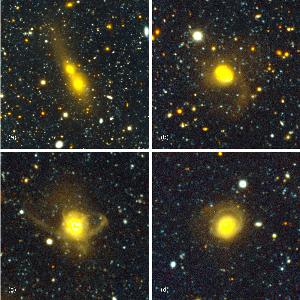GALAXY COLLISIONS DOMINATE THE LOCAL UNIVERSE
Press release
Image:
(click here for a larger version
and here
for a full resolution 11 MB tiff file):

Explanation: The panels
show several of the newly found galaxy collisions in the nearby
universe, using the NOAO Deep Wide-Field Survey (NDWFS) and the
Multiwavelength Survey by Yale/Chile (MUSYC).
The collisions are seen in
different stages of the merger process, which taken together show the
sequence that occurs.
In (a) and (b) [top left and top right], the galaxies are still
separated, but huge tidal forces of gravity are already at work
pulling stars from the galaxies into enormous broad fans that stretch
hundreds of thousands of light-years in space.
In (c) and (d) [bottom left and bottom right], the colliding galaxies
have merged into single, larger galaxies. The violent past of these
galaxies can be inferred from the tidal "debris" that still surrounds
the newly formed galaxies.
Individual eps and fits files
Movie:

MPEG (3.1 MB)
AVI (7.0 MB)
QuickTime (7.0 MB)
Movie by
M. Steinmetz
Explanation:
The movie shows a computer simulation of the formation of a
large galaxy. Time is compressed in the simulation: the entire
history of the universe (13.7 billion years) spans
about 20 seconds. Computer
simulations like these have predicted that all
galaxies grow by collisions, and subsequent
mergers, of smaller galaxies. The new observations demonstrate,
for the first time, that these collisions are indeed very
common in the local universe.
Citation:
Astronomical Journal 130, page 2647-2665 (December 2005).
PDF version
Credits:
Based in Tucson, AZ, the National Optical Astronomy Observatory (NOAO)
consists of Kitt Peak National Observatory near Tucson, AZ, Cerro
Tololo Inter-American Observatory near La Serena, Chile, and the NOAO
Gemini Science Center. NOAO is operated by the Association of
Universities for Research in Astronomy (AURA) Inc., under a
cooperative agreement with the National Science Foundation.
The movie was made by M. Steinmetz at the
Astrophysical Institute of Potsdam, and was published in
New Astronomy 7, page 155 (2002).

